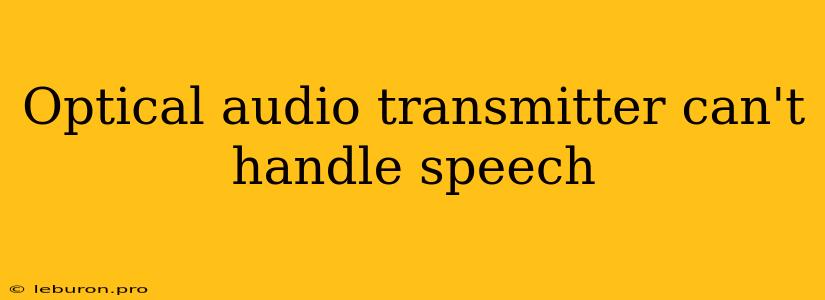The frustration of encountering an audio transmission problem can be a real headache, especially when it involves equipment designed for clear, reliable sound reproduction. One common scenario that can leave users scratching their heads is the inability of an optical audio transmitter to handle speech. This can be a particularly perplexing issue, given the widespread use of optical audio technology for high-quality audio transmission. In this article, we'll delve into the reasons behind this problem, explore the limitations of optical audio transmitters in handling speech, and provide insights into potential solutions and workarounds.
Understanding the Basics: Optical Audio Transmitters and Speech Transmission
Optical audio transmitters, often referred to as "TOSLINK" transmitters, employ light pulses to transmit digital audio signals. They are commonly used for connecting devices like Blu-ray players, soundbars, and AV receivers to home theater systems. While they offer a robust and interference-free connection, they are not inherently designed for transmitting speech signals with the same fidelity as other audio formats.
Limitations of Optical Audio Transmitters in Speech Transmission
The limitations of optical audio transmitters in handling speech can be attributed to several factors:
- Encoding and Decoding: Optical audio transmission relies on a specific encoding scheme, usually Pulse Density Modulation (PDM), to convert audio signals into light pulses. While PDM is effective for transmitting music and other high-fidelity audio content, it can struggle to accurately represent the nuances and subtleties of speech. The digital signal processing (DSP) involved in encoding and decoding speech can introduce artifacts or distortions, leading to a less natural and clear audio output.
- Bandwidth Limitations: Optical audio transmitters typically operate at a fixed bandwidth, which might be insufficient to capture the full range of frequencies present in speech. Speech contains a wide spectrum of frequencies, including high frequencies that contribute to clarity and intelligibility. If the bandwidth is too narrow, some of these high frequencies might be lost during transmission, resulting in a muffled or distorted speech signal.
- Sampling Rate: The sampling rate used for optical audio transmission may not be high enough to accurately capture the fast-changing dynamics of speech. A lower sampling rate can lead to aliasing artifacts and a less natural sound, especially for complex speech patterns with rapid transitions.
Why Speech Transmission Fails: A Closer Look
The inability of an optical audio transmitter to handle speech can manifest in several ways:
- Muddled Speech: Speech might sound muffled, distorted, or unclear, making it difficult to understand the words. This often happens due to bandwidth limitations or insufficient sampling rates, leading to the loss of high-frequency information.
- Choppy or Intermittent Audio: In some cases, the speech transmission might be intermittent or choppy, with sudden breaks or dropouts in the audio. This could be caused by issues with the optical cable, the transmitter itself, or even interference from other devices.
- Complete Audio Silence: The most extreme scenario is when the optical audio transmitter fails to transmit any speech at all. This could be due to a faulty connection, a damaged transmitter, or even a software issue on the receiving device.
Solutions and Workarounds: Addressing the Challenge
While optical audio transmitters might not always be the ideal solution for speech transmission, there are several ways to mitigate these limitations:
- Consider Alternative Connections: If speech clarity is paramount, consider using alternative connections such as HDMI, which offers higher bandwidth and more sophisticated audio processing.
- Upgrade the Transmitter: Explore high-end optical audio transmitters that offer higher bandwidth, advanced DSP algorithms, and more precise encoding schemes.
- Use a Dedicated Speech Encoder: For critical speech applications, a dedicated speech encoder might be necessary. These encoders are designed to handle the unique characteristics of speech, ensuring high-quality transmission and minimal distortion.
- Optimize Audio Settings: On both the transmitting and receiving devices, experiment with different audio settings such as equalization, noise reduction, and volume levels. Adjustments might help improve the clarity and intelligibility of the speech signal.
Conclusion: Navigating the Limitations of Optical Audio Transmitters
While optical audio transmitters offer a robust and interference-free connection for audio transmission, their limitations in handling speech can be frustrating. By understanding the underlying reasons behind these limitations, users can explore alternative solutions, optimize existing setups, or seek professional assistance.
If you are experiencing problems with speech transmission over optical audio, remember that the issue is often a result of a mismatch between the technology and the type of audio content being transmitted. By considering the appropriate solutions and workarounds discussed here, you can overcome this challenge and achieve clear, reliable speech transmission for your audio systems.
